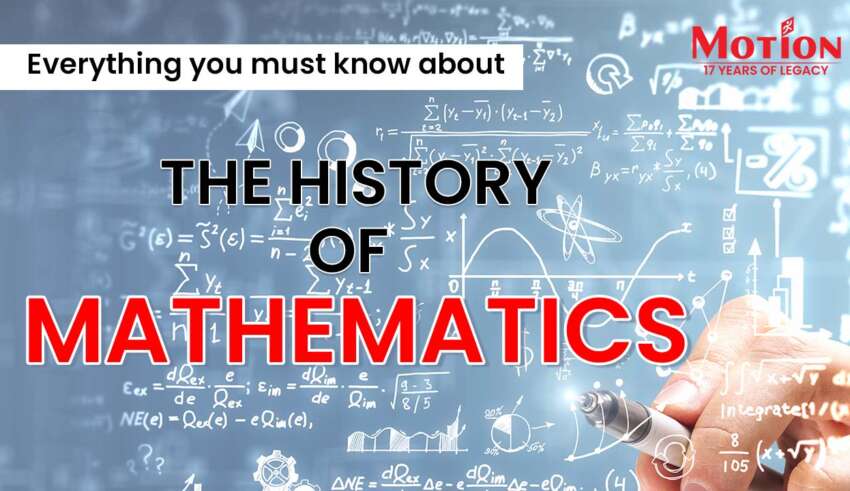
History of Mathematics
The history of mathematics is a fascinating journey that stretches back thousands of years. It began with early humans using simple methods to count and measure things, like marking notches on bones. As civilizations grew in places like Egypt and Mesopotamia, they developed more advanced math to solve problems related to farming, trade, and building.
In ancient Greece, thinkers like Pythagoras and Euclid made huge advances in math. They figured out important ideas about shapes and numbers that people still use today. Around the same time, in places like India and the Middle East, mathematicians were discovering new ways to solve problems with numbers and shapes. These ideas traveled to Europe during the Middle Ages, where they sparked a renewed interest in math and helped lay the groundwork for modern mathematics.
From the Renaissance onwards, the history of mathematics took off with incredible discoveries. Thinkers like Isaac Newton and Carl Friedrich Gauss made huge advances in how we understand motion and solve difficult math problems.
Their ideas from this pivotal time (race against time phrase meaning) in the history of mathematics have shaped our world today. Math isn’t just (just in case definition) about numbers; it’s essential in science, technology, and everyday life. It helps us build bridges, send rockets into space, and understand how diseases spread. The history of mathematics keeps evolving, with each new idea building on the achievements of the past, pushing us to explore and understand our world even better.
What Is The Definition of Mathematics?
Mathematics is the systematic study of numbers, shapes, patterns, and relationships that evolved from fundamental human activities like counting, measuring, and identifying shapes. It forms the bedrock of disciplines such as engineering, science, and philosophy by providing a framework to understand order, relation, and structure in the world around us.
Over time, mathematics has expanded its scope through the application of imagination, logic, and abstraction. It encompasses a diverse array of fields including logical reasoning, quantitative calculation, number theory, geometry, algebra, calculus, probability, statistics, and specialized areas. Mathematics is not just about learning formulas and equations; it equips us with tools to analyze problems, make predictions, and innovate across various domains. Mastering mathematics fosters critical thinking and problem-solving skills, making it an essential subject for intellectual growth and practical application in both academic pursuits and everyday challenges.
Read More:
- Most Famous Indian Mathematicians and Their Contributions
- List of Great Indian Scientists who changed the World by their Contributions
Role of Mathematicians:
Great mathematicians throughout history have left a lasting impact with their innovative thinking and dedication to mathematics. They have gifted the world with remarkable insights and discoveries that continue to shape our understanding today. By exploring the history of mathematics, we uncover the stories of when and how these breakthroughs were made, revealing the importance of math in shaping the world.
Understanding the history of mathematics is crucial because it shows how mathematical ideas have evolved over time and contributed to advancements in science, technology, and everyday life. It highlights the creativity and ingenuity of those who have passionately pursued mathematical knowledge, leaving a legacy that continues to influence and inspire new generations.
Prehistoric Mathematics or the Origin:
Prehistoric mathematics or the Origin refers to the mathematical practices and concepts developed by early human societies before written records were created. This era spans a vast period of human history, encompassing the time when humans relied on oral traditions and practical knowledge rather than written texts to transmit information.
Basic Number System:
Humans started counting around 40,000 years ago using tally marks and fingers to track animals and days. Early societies understood ‘one’ and ‘two’ and later developed symbols for larger numbers as civilizations grew. Numbers were practical tools for daily tasks, evolving in response to survival needs and local trade, rather than being theoretical or standardized.
Prime Numbers and Shapes:
Early mathematical artifacts like the Ishango bone (circa 10,000 BC) reveal early prime number sequences. In later periods, geometric shapes in Predynastic Egypt (5th millennium BC) and megalithic monuments in England/Scotland (3rd millennium BC) were used practically in architecture and construction, initially more for artistic purposes than mathematical understanding.
Civilization and Math Importance:
The rise of agricultural trade among early civilizations like the Sumerians and Babylonians necessitated precise land measurement, taxation, and trade pricing. They developed basic geometric and arithmetic systems to meet these practical needs, embedding mathematics into governance and daily life. This foundational role of mathematics laid the groundwork for advancements in science, technology, and economic systems, shaping the trajectory of human civilization.
Mathematics in Sumer and Babylon (Ancient Mesopotamia) [1st and 2nd Millennium BC]:
In ancient Mesopotamia, during the 1st and 2nd millennia BC, the Sumerians and Babylonians made significant advancements in mathematics. Sumer, located in modern-day Iraq, is renowned as the Cradle of Civilization for pioneering inventions like writing, irrigation, and agriculture. They used wedge-shaped symbols on clay tablets, known as cuneiform script, which marked the birth of a written language system. As agricultural and trade activities increased, they developed a sophisticated arithmetic system to manage land measurements, taxes, and trade deals. They used symbols to represent large numbers and created their lunar calendar for tracking time. Over time, these symbols evolved into more complex cuneiform characters that were used for writing and recording information. These mathematical achievements laid the groundwork for later developments in science, technology, and civilization, shaping the world we know today.
Arithmetic System:
- They used a number system based on 60, where they counted using 12 knuckles on one hand and 5 fingers on the other hand. This system was similar to Roman numerals in that it was a place-value system. In this system, larger numbers were represented by digits placed in columns from right to left.
- The Babylonian base 60 numeral system shaped our measurement of time and angles, giving us 60 seconds in a minute, 60 minutes in an hour, and 360 degrees in a circle—a legacy still used today in modern systems of measurement.
- The Babylonians chose a base 60 system for their math because 60 can be divided evenly by many numbers like 1, 2, 3, 4, 5, 6, and 10, making calculations easier. Similarly, the number 12 is handy because it can be divided by 1, 2, 3, 4, and 6. That’s why we use 12 inches in a foot, 12 months in a year, and two sets of 12 hours in a day. These numbers were picked because they fit well into how we measure things and keep track of time.
The Famous Clay Tablets:
- Many ancient Babylonian clay tablets have been found that cover a wide range of topics like multiplication, division, square roots, cube roots, algebra, and various types of equations. They also include geometric calculations for areas of shapes and volumes of cylinders. Buildings and dice designs were often based on geometric shapes during this period.
- One famous tablet, the Plimpton 322 clay tablet, shows knowledge of right-angled triangles long before Pythagoras’ theorem was known. However, some experts argue that these tablets were primarily used for educational purposes and may not represent practical applications.
Mathematics in Egypt [2000 – 6000 BCE]:
Early Egyptians, living along the Nile valley, observed lunar phases for agricultural and religious purposes. Their measurements were based on body parts, and they used a numeric system based on our ten fingers. They didn’t have place value but used symbols like strokes for units, heel-bones for tens, coils of rope for hundreds, and lotus plants for thousands to represent numbers.
Famous Texts:
- The Rhind Papyrus, dating from 2000-1800 BCE, is a notable Egyptian mathematical text. It includes formulas for geometry, division, multiplication, and information about prime and composite numbers. It also provides solutions for linear equations.
- The Moscow Papyrus, from the same period, features word problems that made mathematics more engaging and practical.
- The Berlin Papyrus contains evidence of solving second-order algebraic equations.
Egyptian Pyramids and Rules of Triangles:
- Egyptian pyramids showcase the mathematical expertise of Egyptian scholars. They demonstrate the knowledge of the perfect formula for pyramid volume, which adheres to the golden ratio of 1:1.618.
- Egyptian builders were skilled in creating perfect right-angled triangles, highlighting their understanding of triangle rules and geometry.
Greek Mathematics [4th – 7th Century BC]:
The Greek empire expanded widely and absorbed knowledge from societies like the Babylonians and Egyptians, enriching their mathematical understanding. They developed their numeral system similar to the Roman numerals.
Great Greek Mathematicians:
- Thales, one of the Seven Sages of Ancient Greece, laid the groundwork for abstract geometry with his theorems, including Thales’s Theorem and the Intercept Theorem.
- Pythagoras, considered the father of Greek mathematics, introduced the Pythagorean Theorem, a fundamental mathematical principle.
- Democritus discovered that a cone’s volume is one-third that of a cylinder with the same height and base.
- Other Notable Mathematicians- Plato, Aristotle, Archimedes, Euclid, and Pappus of Alexandria contributed significant theorems and logical approaches to mathematics.
Influence on Geometry:
- Greek mathematicians tackled major geometric problems such as squaring the circle, doubling the cube, and trisecting an angle, which influenced future developments in geometry.
- They were pioneers in exploring concepts like infinity through Zeno’s Dichotomy Paradoxes.
Mathematics in India [5th – 12th Century]:
The history of mathematics in India dates back to ancient times, particularly from the 5th to 12th centuries, known as its Golden Era. During this period, Indian mathematicians made significant advancements that paralleled developments in the West, leading to claims of plagiarism by European mathematicians.
Arithmetic System:
- During the Vedic period before 1000 BCE, ancient Indians used arithmetic for basic operations such as addition, subtraction, multiplication, and division.
- They also developed methods for calculating squares, cubes, fractions, and roots.
- Indians perfected the decimal place value system, similar to the Chinese, which was a significant intellectual innovation.
Famous Texts:
- Ancient Sanskrit texts dating from the 4th century CE mention different number systems and even estimate the number of atoms in the universe.
- The Sulba Sutras, originating from the 8th century BCE, include simplified versions of the Pythagoras theorem and precise geometric solutions.
- Indian mathematicians discussed infinite numbers and recognized various types of infinities long before such concepts were formalized in the West.
The Greatest innovation of all times – The invention of Zero:
- Credited to mathematician Brahmagupta in the 7th century, the invention of zero is one of India’s greatest contributions to mathematics.
- Brahmagupta established principles for using zero and negative numbers and made significant advances in algebra and quadratic equations.
- Bhaskara II in the 12th century corrected misconceptions about division by zero, explaining its result as infinite.
Trigonometry:
- During India’s Golden Age, significant progress was made in trigonometry.
- The Surya Siddhanta, a text from around 400 CE, contains the earliest known use of trigonometric functions.
- Mathematician Aryabhata in the 6th century CE provided definitions and complete tables of trigonometric functions, using them to calculate distances and approximate the Earth’s circumference using the value of π.
Mathematics in Medieval Europe and Renaissance:
From the 4th to the 12th century, Europe focused more on spiritual, literary, and philosophical pursuits, with minimal progress in mathematics compared to China, India, and the Islamic regions. They relied on Greek teachings like Euclid’s geometry and used Roman numerals and abaci for trade and calculations.
Rise of Mathematics in Europe:
- After the 12th century, mathematics became more practical in Europe due to increased trade with the East and West.
- The introduction of the printing press in the mid-15th century accelerated the spread of mathematical knowledge.
- Books on arithmetic educated businesspeople on computational methods essential for trade and commerce.
The Great European Mathematicians:
Leonardo of Pisa (Fibonacci):
- Introduced the Fibonacci sequence of numbers.
- Spread the Hindu-Arabic numeral system in Europe during the 13th century, replacing Roman numerals.
- Paved the way for significant mathematical innovations in Europe.
Nicole Oresme (14th century):
- Introduced graphs for time-speed-distance relationships.
- Developed the system of rectangular coordinates.
- Explored fractional exponents and infinite series, contributing to mathematical theory.
Regiomontanus (15th century):
- Advanced trigonometry as a distinct field separate from astronomy.
- Authored “De Triangulis”, a seminal work in trigonometry used in schools and colleges.
- Established trigonometry as an independent part of mathematics, fostering its development.
Mathematics During Renaissance:
During the Renaissance, Italian artists and merchants played a crucial role in advancing mathematics. Algebra and arithmetic developed alongside each other, even though they aren’t directly related. These mathematical tools were vital for complex trading and interest calculations.
The Great Mathematicians:
- Piero Della Francesca, in the 14th century, wrote extensively on linear perspective and solid geometry.
- Luca Pacioli, another notable mathematician of that era, introduced the plus and minus signs for the first time in his book Summa de Arithmetica, which was also the first algebra book printed in Italy.
- In the 16th century, Scipione del Ferro and Niccolò Fontana Tartaglia found solutions for cubic equations.
- Gerolamo Cardano’s 15th-century book by Ars Magna solved quartic equations, advancing math with complex problems up to the fourth power.
- Simon Stevin’s work “De Thiede” influenced the development of the real number system by systematically introducing decimal notation for the first time.
Mathematics and the Scientific Revolution:
Mathematics in the 17th Century:
Mathematics in the 17th century, known as the Age of Reason, sparked a surge of scientific and mathematical ideas throughout Europe.
The Great Mathematicians and Their Innovations:
| The Great Mathematicians | Their Innovations |
| John Napier | · Introduced logarithms, simplifying complex calculations for scientists like Kepler and Newton.
· Advanced astronomy, physics, and mathematics by making intricate computations relatively easy. |
| René Descartes | · Developed analytic geometry and Cartesian coordinates.
· Enabled precise plotting of planetary orbits on graphs. · Laid the foundation for calculus, revolutionizing mathematical analysis. |
| Pierre de Fermat and Blaise Pascal | · Established concepts in probability theory.
· Contributed to understanding the likelihood of events and expected outcomes. · Highlighted the practical applications of mathematics in predicting uncertainties. |
| Sir Isaac Newton | · Formulated the laws of physics, fundamentally changing our understanding of the universe.
· Co-developed calculus with Gottfried Leibniz. · Introduced differentiation and integration, essential tools in science and engineering. |
Mathematics in the 18th Century:
The Great Mathematicians and Their Innovations:
| The Great Mathematicians | Their Innovations |
| The Bernoulli of Basel and Leonhard Euler | Dominated 18th-century mathematics with contributions in calculus, probability, number theory, geometry, trigonometry, and algebra. |
| Christian Goldbach | Proposed the Goldbach Conjecture and proved the Goldbach-Euler Theorem on perfect powers in number theory. |
| Abraham de Moivre | Formulated de Moivre’s formula linking trigonometry and complex numbers. Contributed to Newton’s binomial theorem, analytic geometry, and probability theory. |
| Joseph Louis Lagrange | Credited with the four-square theorem and Lagrange’s Mean Value Theorem in calculus. |
| Pierre-Simon Laplace | Known as “the French Newton” for his work in “celestial mechanics”. |
| Adrien-Marie Legendre | Made significant contributions to abstract algebra, statistics, number theory, and mathematical analysis. |
Mathematics in the 19th Century:
The Great Mathematicians and Their Innovations:
| The Great Mathematicians | Their Innovations |
| Joseph Fourier | · Introduced the Fourier series, a powerful tool using trigonometric functions for studying infinite sums.
· Applied his series in both pure and applied mathematics, influencing fields like physics and engineering. |
| Jean-Robert Argand | · Developed the Argand Diagram, a graphical representation of complex numbers using trigonometry and vectors.
· Popularized visualizing complex numbers and their operations geometrically. |
| Évariste Galois | · Proved that polynomial equations with degrees greater than four generally have no algebraic solution.
· Made significant contributions to group theory, rings, vector spaces, algebraic geometry, and non-commutative algebra. |
| Carl Friedrich Gauss | · Dubbed the “Prince of Mathematics” for his wide-ranging contributions across various mathematical disciplines.
· Advanced number theory, statistics, differential geometry, and electromagnetism, among other fields. |
Mathematics in the 20th Century:
The Great Mathematicians and Their Innovations
| The Great Mathematicians | Their Innovations |
| G.H. Hardy and Srinivasa Ramanujan | · Attempted solutions to the Riemann hypothesis, a fundamental problem in number theory.
· Their collaboration brought profound insights into mathematical analysis and special functions. |
| Bertrand Russell and A.N. Whitehead | · Co-authored “Principia Mathematica“, a monumental work that influenced both mathematics and philosophy.
· Laid down rigorous foundations for mathematics and explored the limits of logical reasoning. |
| Other Notable Mathematicians | · Johann Gustav Hermes, David Hilbert, Kurt Gödel, Alan Turing, John von Neumann, Claude Shannon, Andrey Kolmogorov, André Weil, Paul Erdős, Paul Cohen, Julia Robinson, Yuri Matiyasevich |
Mathematics in the 21st Century:
Mathematics in the 21st Century has seen a surge in inaccessible online and print journals. Open-access publishing is becoming more popular, making mathematical research widely available. As computers advance in power and importance, mathematics is expanding its applications, particularly in fields like bioinformatics, where it plays a crucial role in analyzing biological data rapidly and accurately.
Mathematics: Key to Success in JEE Main 2026
Mathematics plays a crucial role in JEE Main 2026, a highly competitive exam for engineering aspirants in India. Success in this exam requires a solid grasp of all subjects, especially Mathematics.
Question Paper Pattern:
The JEE Main exam consists of three major subjects: Physics, Chemistry, and Mathematics. Each subject has a separate section worth 100 marks, with 25 questions in each section.
Important Topics:
Scoring in the Mathematics section of JEE Main 2026 relies heavily on thorough practice. Below are the key topics and chapters essential for success.
- Binomial Theorem
- Conic Sections
- Complex Numbers
- Circles
- Differentiation
- Differential Equations
- Integration
- Limits and Continuity
- Matrices and Determinants
- Probability
- Permutation and Combination
- Quadratic Equations
- Straight Lines
- Sets, Relations and Functions
- Sequences and Series
- Trigonometry
- Three Dimensional Geometry
- Vector Algebra
Quick Tips for Preparation:
- Understand the entire syllabus thoroughly.
- Practice regularly, solving previous years’ papers and using the NCERT mathematics textbook.
- Revise consistently to retain knowledge across multiple topics.
- Improve calculation speed through practice, which helps manage time effectively during the exam.
Frequently Asked Questions- History of Mathematics
Q1. Who is considered the “father of mathematics”?
Ans. Archimedes, (287-212 BC) is known to be the Father of Mathematics.
Q2. Who introduced the concept of zero in mathematics?
Ans. Brahmagupta, an Indian mathematician, introduced the concept of zero.
Q3. Why is the history of mathematics important?
Ans. Studying the history of Mathematics shows how tools for solving problems have changed, helping us understand math better today.
Q4: How does studying the history of mathematics contribute to our understanding of the subject today?
Ans: Exploring the history of mathematics provides insights into the origins and development of mathematical concepts. It shows how ideas evolved through interactions between different cultures and civilizations, shaping the way we approach mathematical problems and applications today. Understanding this evolution helps us appreciate the diversity and richness of mathematical thought across time.
Q5: What role did ancient civilizations like Egypt and Mesopotamia play in the development of mathematics?
Ans: Ancient civilizations such as Egypt and Mesopotamia made significant contributions to the history of mathematics. They developed practical mathematical systems to solve problems related to agriculture, trade, and construction. These early mathematical innovations laid the foundation for more sophisticated mathematical theories and methods that emerged in later centuries.
Q6: How did the Renaissance period influence the history of mathematics?
Ans: The Renaissance marked a revival of interest in learning and intellectual pursuits, including mathematics. Scholars and thinkers during this period rediscovered and built upon ancient mathematical texts from Greece, India, and the Middle East. This intellectual exchange led to advancements in areas such as algebra, geometry, and calculus, setting the stage for the scientific revolution that followed.
Q7: What role did Indian mathematicians play in the history of mathematics?
Ans: Indian mathematicians made significant contributions such as the invention of zero, the decimal system, and early advancements in algebra and trigonometry. These ideas spread to the Islamic world and later to Europe, shaping mathematical thinking globally.
Q8: What are the Sulba Sutras and their significance in the history of mathematics?
Ans: The Sulba Sutras are ancient Indian texts appended to the Vedas, focusing on geometry and mathematics. They provide instructions for constructing altars and fireplaces with precise geometric measurements, showcasing early mathematical applications in ancient India and influencing the development of mathematical ideas.











